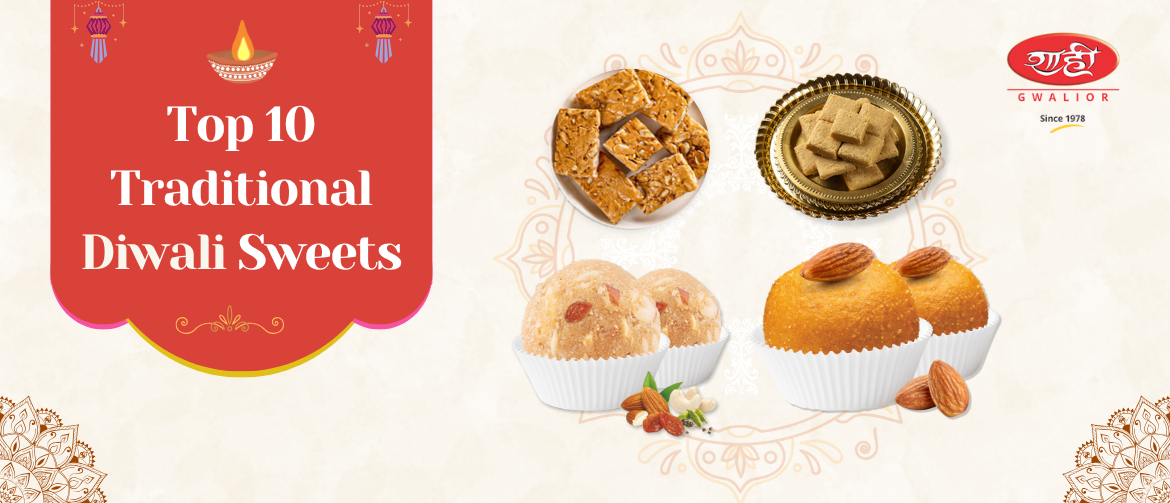No Diwali celebration in India is ever complete without the irresistible charm of mithai. From golden ladoos stacked high on silver platters to flaky soan papdi boxes passed around during card games, sweets are more than just food — they’re symbols of joy, prosperity, and togetherness.
Each region of India brings its own flavour to the festival, but certain classics have earned a permanent place on every Diwali table. These sweets are not just recipes; they carry stories of tradition, family gatherings, and the warmth of sharing.
In this guide, we’ll explore the Top 10 traditional Diwali sweets that brighten homes across the country. From melt-in-the-mouth kaju katli to syrupy gulab jamuns, discover what makes each of these festive treats special, along with tips to enjoy and present them beautifully this Diwali.
Significance of Sweets in Diwali
In India, sweets are not just about satisfying a sweet tooth — they are woven into the very fabric of celebrations. Diwali, the Festival of Lights, is incomplete without mithai, which represents happiness, prosperity, and the sweetness of new beginnings. Sharing sweets is seen as a way of spreading good fortune and strengthening bonds with family, friends, and neighbours.
From temples to homes, offering mithai is a symbolic act of devotion and gratitude. Many families prepare traditional recipes that have been passed down for generations, making sweets a bridge between the past and present. The very sight of ladoos, pedas, and barfis stacked neatly in decorative boxes sets the festive mood.
In today’s times, when gifting has become a big part of Diwali, sweets still hold pride of place. Whether homemade or picked up from famous sweet shops, mithai remains the most loved festive gift — because no box of chocolates or dry fruits can quite replace the nostalgia and cultural significance of a box of gulab jamuns or kaju katli.
Top 10 Traditional Diwali Sweets
Diwali tables across India are a riot of colours, aromas, and flavours — and at the centre of it all is mithai. While modern desserts and fusion sweets find their way into hampers today, nothing compares to the charm of traditional sweets that have stood the test of time. These delicacies not only please the palate but also carry with them the legacy of Indian kitchens, festive rituals, and community bonding.
Here’s a handpicked list of 10 timeless Diwali sweets that continue to brighten homes and hearts across generations.
1. Soan Papdi
No Diwali gift box feels complete without the iconic soan papdi, with its golden, flaky layers that melt almost instantly in your mouth. Made with gram flour, ghee, and sugar, this sweet has a light, airy texture that makes it easy to indulge in “just one more piece.”
Though once considered the most common mithai in gift packs, soan papdi has made a comeback with gourmet flavours like chocolate, pistachio, and saffron. Its crisp yet soft structure also makes it a favourite among children and elders alike.
2. Kaju Katli
Thin, diamond-shaped slices of kaju katli are a symbol of elegance on the Diwali table. Made with ground cashews, sugar, and a hint of cardamom, this mithai is prized for its smooth texture and subtle flavour.
Traditionally topped with silver leaf (varak), kaju katli is often the first sweet to disappear from any platter. Its rich nutty taste and melt-in-the-mouth quality make it one of the most sought-after festive treats across India.
3. Gajak
A winter speciality from North India, gajak makes a star appearance during Diwali thanks to its nutty crunch and warming sesame flavour. Made with jaggery and sesame seeds, it is both delicious and nourishing, keeping the body warm in colder months.
Its long shelf life also makes gajak a practical sweet for gifting. Variants with peanuts, dry fruits, and even chocolate have gained popularity, but the traditional sesame-jaggery combination remains unmatched.
Related Blog: What is Gajak: Preparation, Varieties, Benefits & More!
4. Chikki
Much like gajak, chikki is another crunchy delight that holds a special place in festive spreads. Originating from Maharashtra, it is typically made with roasted peanuts and jaggery, although cashew, pista, and dry fruit versions are equally loved.
Chikki is not just a sweet but also a nostalgic snack, reminding many of childhood winters and festive fairs. Its combination of sweetness and crunch makes it a crowd-pleaser at Diwali gatherings.
Related Blog: What is Chikki: Preparation, Varieties, Benefits & More!
5. Besan Laddu
Golden, round, and aromatic — besan laddus are among the most traditional sweets prepared at home during Diwali. Made with roasted gram flour, ghee, and sugar, these laddus carry a comforting, nutty flavour.
Every household has its own secret way of preparing besan laddus, with variations in texture — some prefer them grainy, others smooth. Their simplicity, paired with their festive significance, makes them an evergreen favourite.
6. Dry Fruit Laddu
Packed with almonds, cashews, pistachios, figs, and dates, dry fruit laddus are the healthier cousin in the Diwali sweet spread. Naturally sweetened with dates or jaggery, they offer a rich, chewy bite that doubles up as an energy booster.
These laddus are especially popular among families looking for a guilt-free festive indulgence. Their long shelf life also makes them ideal for gifting and traveling during the season.
Related Blog: Dry Fruit Laddu Recipe: Healthy & Tasty Sweet for All Ages
7. Doda Barfi
A Punjabi classic, doda barfi is a dense, fudgy sweet made from milk, ghee, and sprouted wheat flour. Its rich caramelised flavour comes from slow cooking, which gives it a grainy yet melt-in-mouth texture.
This mithai is considered more indulgent than regular milk barfi and is often garnished with nuts. With its deep, earthy taste, doda barfi adds variety to the otherwise nut- and syrup-heavy festive spread.
8. Gulab Jamun
Perhaps the most iconic Indian dessert, gulab jamuns are soft, syrup-soaked balls that bring instant joy to any celebration. Traditionally made with khoya (milk solids) and fried to golden perfection before being dipped in rose-scented sugar syrup, they are loved across age groups.
Whether served warm or at room temperature, gulab jamuns are a symbol of indulgence and hospitality. No Diwali feast is ever truly complete without them.
9. Motichoor Laddu
These bright orange pearls are a Diwali staple, especially in North Indian households. Made from tiny, fried droplets of gram flour bound together with sugar syrup, motichoor laddus are soft, delicate, and bursting with sweetness.
Often offered to deities during Diwali puja, motichoor laddus also hold pride of place in festive gift boxes. Their vibrant colour and celebratory feel make them one of the most festive-looking sweets.
10. Milk Cake
Milk cake, also known as Alwar ka mawa, is a rustic sweet that’s as simple as it is satisfying. Prepared by reducing milk until it thickens and then sweetened, it has a unique caramelised flavour with a slightly grainy texture.
Its humble look often belies its taste, which is rich, deep, and memorable. Milk cake is particularly popular in Rajasthan and Uttar Pradesh but is loved nationwide during Diwali for its authenticity and charm.
Tips for Storing Diwali Sweets
With so many varieties of mithai prepared and gifted during Diwali, proper storage becomes essential. Some sweets have a long shelf life, while others need to be consumed within a couple of days. Storing them correctly ensures they stay fresh, safe to eat, and retain their authentic taste and texture.
Here are some simple yet effective tips to keep your festive sweets in the best condition:
- Check Shelf Life: Fresh milk-based sweets like rasgulla, gulab jamun, and peda should be consumed within 2–3 days, while dry sweets like soan papdi, chikki, and dry fruit laddus last longer.
- Use Airtight Containers: Store sweets in clean, airtight boxes to prevent them from absorbing moisture or odours from other foods.
- Refrigerate Milk-Based Sweets: Keep sweets made with milk, khoya, or paneer in the refrigerator to avoid spoilage. Bring them to room temperature before serving.
- Separate Dry and Syrupy Sweets: Do not store dry sweets with syrupy ones, as the moisture can make dry items soggy and spoil faster.
- Avoid Direct Sunlight: Always keep mithai away from heat sources and direct sunlight, as sugar can crystallise and ghee can turn rancid.
- Use Food-Grade Wrapping: If gifting, wrap sweets in butter paper or food-safe foil before boxing them to lock in freshness.
- Consume on Time: Even with refrigeration, avoid keeping mithai for too long. Enjoying them fresh ensures the best flavour and prevents waste.
FAQs About Traditional Diwali Sweets
Still have questions about mithai this festive season? Here are some commonly asked queries answered simply for you:
Q1. How long do Diwali sweets stay fresh?
The freshness depends on the type of sweet. Milk-based sweets like gulab jamun, rasgulla, peda, or milk cake typically last 2–3 days when refrigerated. On the other hand, dry sweets such as soan papdi, gajak, or dry fruit laddus can stay fresh for up to 7–10 days if stored properly in airtight containers. Always check for changes in taste, smell, or texture before serving.
Q2. Which sweet is considered most auspicious during Diwali?
Laddus, especially motichoor and besan laddus, are considered very auspicious. They are often offered to Lord Ganesha and Goddess Lakshmi during Diwali puja, symbolising prosperity and the sweetness of new beginnings. In many households, preparing laddus marks the start of festive cooking.
Q3. Are there sugar-free options for Diwali sweets?
Yes, many traditional sweets now have sugar-free or low-sugar versions. Dates, jaggery, or natural sweeteners are often used in place of refined sugar. Dry fruit laddus, fig-and-date rolls, and sugar-free
barfis are popular choices for health-conscious families. These options allow everyone to enjoy festive indulgence without guilt.
Q4. What are the most popular sweets for Diwali?
Classics like kaju katli, gulab jamun, motichoor laddus, soan papdi, and barfi top the popularity charts every year. These sweets are widely loved across India and also make the most common gifts exchanged during Diwali. Their universal appeal ensures they find a place on almost every festive table.
Q5. Can I make traditional Diwali sweets at home?
Absolutely! Many traditional recipes like besan laddus, chikki, or milk barfi can be made at home with basic ingredients. Homemade sweets not only carry a personal touch but also allow you to control the quality of ghee, sugar, and flavours. For those short on time, semi-homemade kits and pre-mixes available in the market make festive cooking easier.
Conclusion
Diwali is more than just a festival of lights — it’s a celebration of togetherness, joy, and traditions that have been passed down for generations. And at the heart of these traditions lie sweets, which bring families closer and add flavour to every gathering.
From the flaky layers of soan papdi to the richness of kaju katli and the syrupy indulgence of gulab jamun, every mithai tells a story of heritage and happiness. As you prepare your festive table or gift boxes this year, let these timeless sweets remind you that Diwali is best celebrated with love, light, and a touch of sweetness.
Celebrate Diwali with Authentic Sweets from Shahi Food Products!
No Diwali celebration is truly complete without a spread of authentic mithai made with love, care, and the finest ingredients. At Shahi Food Products, we bring you a wide range of traditional Diwali sweets crafted to perfection — from melt-in-the-mouth kaju katli and flaky soan papdi to rich gulab jamuns and wholesome dry fruit laddus.
Whether you’re looking to brighten your festive table or surprise loved ones with thoughtful gifts, Shahi Food Products ensures quality, freshness, and the authentic taste of tradition in every bite. This Diwali, celebrate the festival of lights with sweets that are as pure and delightful as the occasion itself.
 +91 9926520003
+91 9926520003 sales@shahifood.in
sales@shahifood.in Delivery Charges : ₹199
Delivery Charges : ₹199


